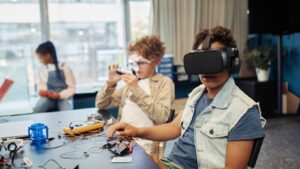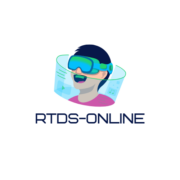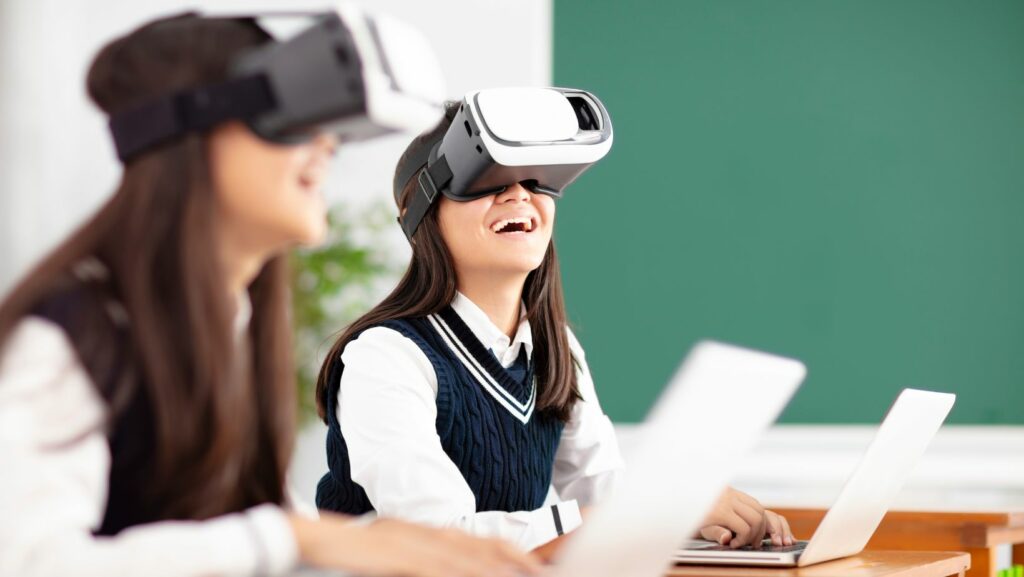Imagine stepping into a classroom where you can explore the depths of the ocean, walk on Mars, or dissect a frog without the mess. Welcome to the world of Virtual Reality (VR) in education. This isn’t the future, it’s happening right now, transforming learning into an immersive, interactive experience.
VR educational experiences are pushing the boundaries of how we learn, making education more engaging and fun. They’re not just about gaming, they’re about creating a whole new way to understand complex concepts.
VR Educational Experiences
From Early Concepts to Modern Implementations
 In its infancy, VR served as a tool mainly for gaming and entertainment. However, visionary educators recognized its potential for more transformative purposes, notably in the education sphere. As early as the 20th century, researchers experimented with this empowering technology, leveraging it for educational purposes.
In its infancy, VR served as a tool mainly for gaming and entertainment. However, visionary educators recognized its potential for more transformative purposes, notably in the education sphere. As early as the 20th century, researchers experimented with this empowering technology, leveraging it for educational purposes.
In the progressive era, more sophisticated VR technologies saw the light of day. These included VR headsets like Oculus Rift and HTC Vive, providing a more immersive experience. From these devices stemmed the VR classrooms, virtual field trips, and augmented reality textbooks of today’s education systems.
Impact on Traditional Learning Methods
The impact of VR on traditional learning methods is profound. By transporting learners into virtual environments, VR provides them with a first-hand experience of the subjects they study. Contrast this to traditional learning methods, where concepts often remain abstract and distant.
Moreover, VR makes content more accessible, breaking down geographical limitations. Virtual field trips enable students to visit historical sites or natural wonders from anywhere in the world, a spectacle that traditional teaching methods can’t offer.
Key Benefits of VR in Education
Immersive Learning Environments
 Firstly, VR fosters immersive learning environments, bringing a new perspective to education. Instead of memorizing abstract concepts from a book or passively listening to lectures, students dive into the learning process. They immerse themselves in realistic, 3-dimensional scenarios that are constructed to mimic real-life situations. For instance, medical students can explore the human heart, navigating through veins and arteries, gaining an unprecedented understanding of the organ’s complex structure and functions.
Firstly, VR fosters immersive learning environments, bringing a new perspective to education. Instead of memorizing abstract concepts from a book or passively listening to lectures, students dive into the learning process. They immerse themselves in realistic, 3-dimensional scenarios that are constructed to mimic real-life situations. For instance, medical students can explore the human heart, navigating through veins and arteries, gaining an unprecedented understanding of the organ’s complex structure and functions.
Enhanced Engagement and Retention
On the other hand, VR doesn’t just captivate students—it enhances both engagement and retention. Traditional teaching tools often struggle to maintain students’ interest over a prolonged period, a constraint addressed aptly by VR. It doesn’t merely provide visual aid, it puts students in the heart of the subject material.
As an example, consider a history lesson about Ancient Rome. Using VR, students can virtually visit the Roman Empire, walk the streets, enter iconic buildings, and truly grasp the grandeur of that era, rather than merely imagining based on textual descriptions. By this active participation, students’ retention and grasp of concepts significantly improve.
Challenges and Limitations of VR in Education
Technological and Accessibility Issues
 Despite the advancements in VR technology, key concerns lie in technological compatibility and accessibility. For instance, VR fails to find universal access due to economic constraints. High-quality VR hardware amounts to a significant cost, making it unaffordable to many schools and students. Additionally, technical difficulties such as quick battery drainage and limited internet bandwidth can hamper the seamless experience promised by VR education.
Despite the advancements in VR technology, key concerns lie in technological compatibility and accessibility. For instance, VR fails to find universal access due to economic constraints. High-quality VR hardware amounts to a significant cost, making it unaffordable to many schools and students. Additionally, technical difficulties such as quick battery drainage and limited internet bandwidth can hamper the seamless experience promised by VR education.
Furthermore, VR platforms entail a steep learning curve, making it formidable for some students and educators to grasp. Considering the variances in tech-savviness across student and teacher populations, the adoption of VR isn’t as straightforward as incorporating textbooks or regular digital resources in classrooms.
Balancing Virtual and Traditional Teaching Methods
In the quest to integrate VR experiences, striking a balance between traditional and virtual teaching methods becomes equally challenging. No matter how lifelike the virtual world might be, it can’t entirely replace the tactile experiences and interpersonal relationships fostered in the traditional classroom environment. Real classroom interaction offers benefits such as peer-to-peer learning, relationship-building, and non-verbal communicative gestures, which are irreplaceable by VR simulations.
Consequently, educators struggle to delineate the optimal blend of VR and traditional teaching. While VR can offer immersive, enriched experiences, it must be skilfully interwoven with conventional classroom learning tactics. Only then can education truly harness the full potential of VR and negate the potential hindrance it poses to the tried and true methods of classroom teaching.

